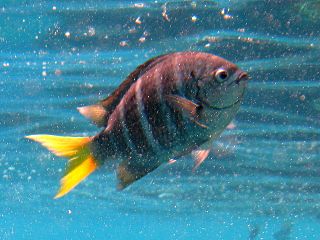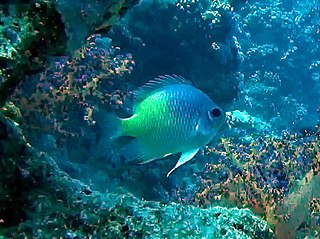
Mackerel is a common name applied to a number of different species of pelagic fish, mostly from the family Scombridae. They are found in both temperate and tropical seas, mostly living along the coast or offshore in the oceanic environment.

The sergeant major or píntano is a species of damselfish. It grows to a maximum length of about 22.9 centimetres (9.0 in).

Abudefduf, also known as the sergeant-majors, is a genus of fish in the family Pomacentridae.

The Indo-Pacific sergeant is a species of damselfish in the family Pomacentridae. It may also be known as the Sergeant major although this name is usually reserved for the closely related species Abudefduf saxatilis. The closely related Abudefduf caudobimaculatus was formerly considered to be synonymous with this species and, according to some authorities, is synonymous.

The green damselfish, also known as the Hawaiian sergeant major, is a non-migratory fish of the family Pomacentridae. It occurs in the Pacific Ocean in the vicinity of the Hawaiian Islands, Midway Island and Johnston Atoll. It can grow to a maximum total length of 30 cm.

Fish are very diverse animals and can be categorised in many ways. Although most fish species have probably been discovered and described, about 250 new ones are still discovered every year. According to FishBase about 34,800 species of fish had been described as of February 2022, which is more than the combined total of all other vertebrate species: mammals, amphibians, reptiles and birds.

Several species of fish are claimed to produce hallucinogenic effects when consumed. For example, Sarpa salpa, a species of sea bream, is commonly claimed to be hallucinogenic. These widely distributed coastal fish are normally found in the Mediterranean and around Spain, and along the west and south coasts of Africa. Occasionally they are found in British waters. They may induce hallucinogenic effects similar to LSD if eaten. However, based on the reports of exposure they are more likely to resemble hallucinogenic effects of deliriants than the effects of serotonergic psychedelics such as LSD. In 2006, two men who apparently ate the fish experienced hallucinations lasting for several days. The likelihood of hallucinations depends on the season. Sarpa salpa is known as "the fish that makes dreams" in Arabic.

Kyphosus azureus, the zebra-perch sea chub, zebra perch or zebra sea chub, is a species of marine ray-finned fish, a sea chub from the family Kyphosidae which is native to the eastern Pacific Ocean coasts of North America.

The yellowtail sergeant is a species of damselfish in the family Pomacentridae native to the Indo-Pacific. It can grow to a maximum total length of 17 centimetres (6.7 in).

The Canary damsel is a species of marine fish of the family Pomacentridae. It lives primary in shallow, subtropical waters of the Atlantic Ocean, and is sometimes also known as the Cape Verde gregory, which is also a common name of Stegastes imbricatus.

Amblyglyphidodon flavilatus, known as yellow damselfish, yellowfin damselfish, yellow flank damselfish, yellow side damselfish, and yellow-sided Damselfish, is part Pomacentridae, which is a family of ray-finned fish including damselfish and clownfish. This family represents the greatest diversity and abundance of fish species inhabiting coral reefs. They were first discovered in the 1980s by Allen and Randall.

The banded grouper, also known as the blunt-headed rock cod, the bighead grouper, white-spotted green grouper, and yellow-lipped rock-cod, is a species of marine ray-finned fish, a grouper from the subfamily Epinephelinae which is part of the family Serranidae, which also includes the anthias and sea basses. It comes from the western Pacific Ocean.

Abudefduf bengalensis, known as the Bengal sergeant or the narrow-banded sergeant major, is a species of damselfish in the family Pomacentridae. It is a marine species native to the tropical Indo-Pacific, where it ranges from the eastern Indian Ocean to Australia and Japan in the Pacific Ocean, and it is not known to occur in the Red Sea. Adults of the species are typically found in coral reef and lagoon environments at a depth of 1 to 6 m, where they typically occur singly or in small groups.
Abudefduf conformis is a species of damselfish in the family Pomacentridae. It is native to the eastern central Pacific Ocean, where it is known from the Marquesas Islands. The species typically occurs in reef environments at a depth of 0 to 12 m.

Abudefduf declivifrons, commonly known as the Mexican nightsergeant, is a species of damselfish in the family Pomacentridae native to the eastern Pacific Ocean. It is known only from Mexico, where it ranges from the Gulf of California to Acapulco. It is typically found in surge-exposed rocky reefs at a depth of 1 to 5 m. It is an oviparous species, with individuals forming distinct pairs during breeding and males guarding and aerating eggs. The species reaches 18 cm in standard length.
Abudefduf hoefleri, commonly known as the African sergeant, is a species of damselfish in the family Pomacentridae. It is native to the eastern Atlantic Ocean where it ranges from Senegal to Benin, including Cape Verde, Ilhéu das Rolas, and São Tomé Island. It is a littoral species typically encountered in rocky reef environments. The species is oviparous, with individuals forming distinct pairs during breeding and males guarding and aerating eggs. Abudefduf hoefleri reaches 20 cm in total length.
Abudefduf natalensis, known as the Natal sergeant, is a species of damselfish in the family Pomacentridae. It is native to the tropical western Indian Ocean, where it is known from Madagascar, Mauritius, Réunion, and South Africa from KwaZulu-Natal to the Eastern Cape. Adults of the species are typically found in rocky reefs at depths of 1 to 25 m. The species is known to be oviparous, with individuals forming distinct pairs during breeding and males guarding and aerating eggs. Abudefduf natalensis reaches 17 cm in total length.
Abudefduf nigrimargo, known as the black margined-scale sergeant, is a species of damselfish in the family Pomacentridae. It is native to the northwestern Pacific Ocean, where it is known only from Taiwan. The species is known to occur above shallow rocky reefs, where it forms feeding aggregations. The habitat in which Abudefduf nigrimargo can be found is also known to be inhabited by the related species Abudefduf vaigiensis and Abudefduf caudobimaculatus. The species reaches 12 cm in standard length.
Abudefduf caudobimaculatus, commonly known as the Okinawa sergeant, is a species of damselfish in the family Pomacentridae. It is native to the Indo-Pacific, where it is believed to range from East Africa to Yakushima and Lord Howe Island, including Taiwan and Indonesia. Although initially described in 1939, it was subsequently considered synonymous with Abudefduf vaigiensis, until a 2017 review conducted by Kunto Wibowo of the Indonesian Institute of Sciences, Hiroyuki Motomura of the Kagoshima University Museum, and Minoru Toda redescribed it as a valid and distinct species. Despite this, it is still listed by FishBase and WoRMS as a synonym of A. vaigiensis.

Abudefduf whitleyi, known as Whitley's sergeant, is a species of damselfish in the family Pomacentridae. It is native to the tropical southwestern Pacific Ocean, where it is known from Australia, New Caledonia, and the Coral Sea. The species is generally found in shallow reef environments at depths of 1 to 5 m, where feeding aggregations of more than a hundred individuals are frequently seen swimming in the water column relatively high above the substrate. It is oviparous, with individuals forming distinct pairs during breeding and males guarding and aerating eggs. Abudefduf whitleyi reaches 14 cm in standard length.















